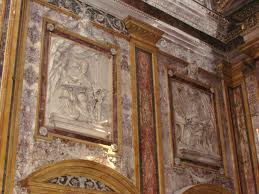
Read English version
- Contatti Associazione culturale e di volontariato”Guardie del Tempio” tel. 3518170095
- Orari visite: chiusa per restauro
- Ticket.
On the Corso Vittorio Emanuele, between Via Maqueda and via Roma, stands the Church of San Matteo. The Facade is typically baroque and there are three statues depicting the Virgin, St. Matthew and St. Matthias. It was started by the will of the Miseremini Opera in 1633 and was founded by Franciscan Friar Leonardo Galici, thanks to the donation of the Building and the garden from Dr. Mario Muta, a famous jurisconsult, who aimed at bringing mercy through prayers to the souls of Purgatory.
It was consecrated in 1647 and ended in 1664 by Carlo D’Aprile and Gaspare Guercio.The Latin cross, with three naves separated by columns, is of the sixteenth-century style. Above the main door you can admire the splendid bas-reliefs by Serpotta, stucco statues depicting Faith and Hope, while Charity and Justice are by Bartolomeo Sanseverino..
In the dome of the central and lateral nave there are the frescoes by Vito D’Anna dating back to 1728. In the right side nave there is a wooden crucifix in a bas-relief relic by Vincenzo Siracusa of the late eighteenth century. In the central nave, the main altar was made by Filippo Cinistri in marbles decorated with agate and
lapis lazuli, with golden wooden bas-reliefs representing biblical scenes. In the center there is a canvas of the year 1796 depicting the purgatory souls by Joseph Testa.
During the period before Easter, the church is the destination of many devotees and visitors as the “Most Blessed Sacramental Brotherhood of the Invalids” during this time the solemn procession of Holy Friday takes place along the streets of the Old Town. Behind the main altar there is the sacristy, furnished by beautiful wooden walnut wardrobes,which were all carved by the sculptor Pietro Marino in 1738.
Among the wardrobes is a genuflector that might hide a secret door.
According to the popular tradition, there is a legend about the sect of the Blessed Paoli that accessed into a secret environment from this door. Within the church is the crypt where the famous sculptor Giacomo Serpotta was buried and worth mentioning is the oratory of Miseremini where you can admire a sculpture by Lorenzo Marabitti, brother of the most famous Ignatius.
- Contacts: Associazione culturale e di volontariato”Guardie del Tempio” tel. 3518170095
- Opening times: closed for restoration
- Ticket
